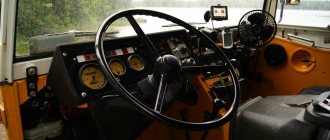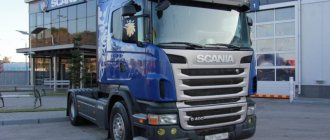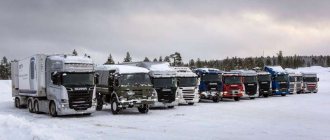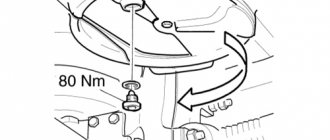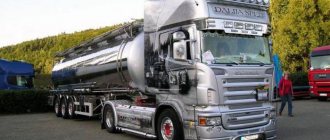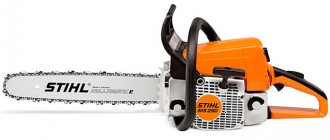Large Scania garbage trucks, capable of transporting up to 12-13 tons of waste at a time, are very popular in our country. Fast, maneuverable and equipped with modern equipment, they can work for a long time and efficiently in both urban and suburban conditions. One such vehicle is capable of replacing an entire fleet of analogues on a ZIL or MAZ chassis.
Garbage trucks on Scania chassis
Scania is a Swedish brand that has long been known and popular in our country. The company has been operating on the market since 1920, supplying consumers with trucks, engines and buses. The proprietary chassis of this brand are highly reliable and adaptable to difficult Russian conditions.
One of the leading manufacturers of garbage trucks based on these chassis is the RG-Techno enterprise from the Moscow region (Lyubertsy). It produces many rear-loading models, differing in wheel configurations, load capacity, body capacity, and functionality. All of them can work with different types of containers and will easily travel both off-road and in tight city streets.
Garbage trucks are installed on several types of chassis. Those that have four wheels are able to maneuver better and turn faster (due to their small overall dimensions and turning radius).
In crowded urban conditions, they turn out to be optimal. The body on them is placed with a capacity of 10 to 17 cubic meters. And six-wheeled chassis, which can carry a body of 18 to 24 cubic meters, are good for working at waste treatment stations and incineration plants.
Among the advantages of Scania equipment are:
- saving diesel fuel;
- increased pressing ratio;
- a cabin with excellent ergonomic characteristics;
- versatility (work with various bunkers and containers);
- higher performance parameters than analogues.
The only downside is that the price is not very affordable. Otherwise the cars are excellent.
STRENGTH AND WEAKNESS OF SCANIA P
SPECIFICATION
Production of a new family of Scania cabover vehicles with the letter “P” to replace the 4th series, better known as the “Bench” and produced since 1995, began in the fall of 2004. The letter began to indicate the type of cabin: “P” - standard. At the same time, the company switched to the 5th generation of machines of the so-called R-series (“R” means “high”), which in 2010 was replaced by the New R-series line.
The “pawn” is produced in three versions - with the indices CP14, CP16 and CP19, and only the last, most spacious of them is held in high esteem by truck drivers. The digital index reflects the rounded depth of the cabin: the distance from the dashboard to the rear wall, which in this case is 1900 mm. The space behind the driver's seat made it possible to place a berth measuring 2130x750 mm, on which a branded mattress 205 mm long is usually used. The height from floor to ceiling is only 1670 mm - after all, the cabin is standard, not high. Since it is installed on the frame lower than that of the same Erka, there is a “hump” inside with a height of about 400 mm, under which there is a shaft of the engine compartment. However, on interregional routes many carriers are not spoiled and are content with such amenities.
As an alternative to the CP19, there is a more spacious cabin - the CG19, used on New Griffin tractors since 2008. It has two “sleepers” with a width of 600 and 700 mm, and the CG19 Highline version has a ceiling raised by 210 mm. By the way, Scania cabs are rightfully considered one of the best on the market in the field of passive safety. Thanks to the rigid frame structure with reinforcement elements, the side pillars and rear wall can withstand a blow of a whole ton, and the roof does not collapse to a dangerous state under the influence of a load weighing 15 tons.
Early models of the “P” series were equipped with 6-cylinder in-line DC11 diesel engines of Euro-2 and Euro-3 standards with PDE high-pressure unit injectors. But such cars are extremely rare on sale now. Later modifications came with an HPI fuel supply system. With an 11 liter engine displacement, tractors of this series were supplied to Russia with two power options: 340 and 360 hp. (at 1900 rpm) and maximum torque of 1600 and 1800 Nm, respectively, at 1050-1350 rpm.
Later, engines appeared with four power settings: 340, 380, 420 and 470 hp. Since the mid-2000s, “Peshki” came with 5-cylinder DC9 engines in Euro-3 and Euro-4 versions with output of 230, 270 and 310 hp. and a torque of 1050-1550 Nm. With the advent of Euro-5, new engines received power characteristics of 280 and 320 hp. However, you shouldn’t bother yourself with such nuances. It is more important to remember that on most Euro-3 and Euro-4 engines Scania used the EGR exhaust gas recirculation system. Simply put, in this case the carrier has a real chance to save money, since AdBlue urea solution is not needed to meet environmental requirements.
Cars with 5- and 6-cylinder engines were equipped with manual transmissions: 8-speed GR900 with a divider and reduction gear; 12-speed GRS890 with range shifter and 12-speed GRS900 with range shifter and two crawler gears. Some versions of transmissions offered an Opticruise system, which automatically selects the most optimal gear for specific driving conditions. Due to faster gear selection during travel, a higher average delivery speed is achieved.
AVAILABILITY
Next year it will be 20 years since Scania AV was officially represented in Russia and 15 years since it acquired importer status. But a lot of cars are still required. Another thing is that not all carriers can afford new tractors, and therefore turn their attention to used equipment.
There was a period when for several years in a row Scania held the palm in sales of new imported trucks in Russia and in some countries of the former USSR. Reliability, comfort and efficiency, without exaggeration, have become the hallmark of products of the Swedish automobile industry. The high residual value and prestige of owning such equipment have led to the fact that the market in the Russian Federation and the CIS is constantly increasing due to the import of not only new, but also used trucks.
You won’t find fresh cars two or three years old on the market during the day: during the global recession there was a huge decline in sales, especially in 2009. And those cars that were purchased during that period had not yet come out of leasing. But on the Internet, in print media and in sellers’ parking lots, cars produced in 2005 and 2006 are well represented. You should choose from them.
Truck tractor Scania P340 Euro-3 2005 (the same Griffin) with a mileage of under 750 thousand km with “mechanics”, ABS and “autonomy” will be offered to you for 1.8 million rubles. Bargaining in this case is appropriate, just don’t think that the seller will give up a lot - he is aware of the current situation. On the other hand, prices are expected to fall in the fall due to a large influx of European second-hand goods in light of Russia's accession to the WTO. And if you have the opportunity to add a million to this amount, you can count on a five-year hitch consisting of an Erka with a 420-horsepower engine and a 97-cube tent truck. So don't be confused: take action and bargain.
However, those who purchase a fresh Viking on their own can expect a catch, and this was reported on the Scania website at the end of April. The information concerned used Scania cars with Euro-5 EGR engines. They are often offered at very attractive prices - 30-40% lower than the cost of Scania with Euro-5 engines with an SCR urea injection system. These vehicles are equipped with an XPI (Common Rail) fuel system. The problem is that Scania EGR Euro-5 engines cannot be used in Russia and are not officially supplied to us!
What is the danger? Experts note: the permissible level of sulfur content in fuel for engine operation is 10 milligrams of sulfur per kilogram of fuel. In our central region, the sulfur content in fuel is on average 20 times higher, and sometimes significantly higher. Sulfur oxide is mixed with water vapor, the resulting sulfuric acid is supplied to the intake manifold and then into the cylinders. In such conditions, engines rarely last more than 100-200 thousand km. The upper parts of the liners and cylinder heads are primarily damaged. If the carrier is not sure which engine is installed on the vehicle selected for purchase, you need to check with technical specialists about the possibility of importing and operating this vehicle in Russia using the chassis number or by phone (ext. 131).
A valuable advantage of Scania P is its maintainability and the availability of spare parts not only from official dealers, but also in specialized spare parts stores. But more on that later.
SERVICE
Prudent drivers plan to carry out the next maintenance with under-mileage or slightly over-mileage at the “home” station. Arriving at someone else's station is a lottery. Of course, in most cases, a branded service will do everything correctly. Another matter is in what time frame and for what money. This is why some Russian truckers prefer to go to Belarus for maintenance and repairs: with a comparable cost per standard hour, original spare parts are still cheaper there.
In the cabin of one of the trucks I saw a mysterious code. The set of letters meant a sequence of different types of TO. The “S-MSL” line corresponded to one service cycle without maintenance, the other (“XSXMXSXL”) corresponded to a service with maintenance. The driver explained: this is necessary so that someone else’s service does not impose a more extensive service that is not justified by operating conditions.
X-service (after 22.5 thousand km) takes approximately 40-45 minutes and includes lubrication of king pins, spring pins, CV joints, and checking the oil level. It prevents premature repairs and replacement of many parts. TO-X is not carried out if the car is operated in favorable conditions: with low dust content in the air, the absence of salt deicing agents on the roads and low (less than 0.2%) sulfur content in diesel fuel. In practice, some carriers do not wait for the treasured 22.5 thousand km, but service the car after 15 thousand km. This is especially true for companies with large fleets that have their own mechanics.
Russian carriers strive not to create unnecessary problems for themselves and often switch to using high-quality fuels and lubricants. For example, in order for a car to start without problems in cold weather, many enterprises have abandoned the use of 15W40 mineral motor oil and switched to 10W40 semi-synthetic. It burns to a lesser extent, which means you don’t have to add as much as in the case of mineral water. But the principle of economy is sometimes observed like this: in the warm season the car runs on mineral oil, in the cold season - on semi-synthetic oil. You won’t feel the difference in a year, but in a few years you will.
Scania owners are advised not to forget about engine idling, taking into account when assessing the conditional mileage and developing a maintenance schedule for each truck individually. This is especially true with the onset of cold weather, when the engine “threshes” for a long time without load. This is also typical for waiting in line for weight control or customs inspection at the border. It is very difficult to keep such records from memory, but if you are focused on long-term operation of the equipment, you should not neglect the manufacturer’s recommendations, especially since they are simple: 150 hours = 10,000 km 300 hours = 20,000 km 450 hours = 30,000 km 600 hours = 40,000 km 750 hours = 50,000 km.
If you buy a used car and don’t know its real condition, it’s better to go to a branded service station and fork out for computer diagnostics. An inspection by specialists will cost no more than the inevitable repairs if hidden defects are discovered.
WARRANTY AND COSTS
The factory warranty for the car is 1 year or 120 thousand km. When purchasing a new truck, as part of a spring promotion, the dealer offers maintenance for 3 years as a gift, which allows you to save up to 500 thousand rubles. In addition, from 1 March to 31 August 2012, Scania has announced special prices for original spare parts and repair packages. They touched on the most popular parts - such as steering rods and ball ends, wheel bearings, driveshaft crosspieces, king pin repair kit, etc. A number of other importers, frankly speaking, do not indulge their clients with such gifts.
According to reviews from carriers, Swedish equipment does not cause any problems in the first year, even if by this time the odometer shows 150-160 thousand km. Problems arise in the second or third year of operation, although they are not fatal. Even after four to five years, there are no issues with the car’s engine, gearbox or axles. Overall the machine is very strong and durable, but requires some attention. Let’s say, after a mileage of about 400 thousand km, the power steering “dies out”. When the speedometer shows 500 thousand km, the clutch wears out its life. The calipers begin to “wedge.” There are problems with the fuel pump. The wheel hub bearings require replacement. Next, parts that are written off due to natural wear and tear complete their life cycle.
So that the car does not cause problems, truckers, when the mileage is 500-600 thousand km, put it in repair for a month and carefully sort it out. If all operations are carried out conscientiously, the “Swede” will serve faithfully for the same amount or at least 450-500 thousand km. However, large companies prefer not to bring the equipment to such a state and, without waiting for a mileage of a million kilometers, put the equipment up for sale.
One of the most reliable parts is the power steering. Cases of their refusal are rare and are not at all typical for Pashka. The steering column shaft created problems only on cars of the first series due to the fact that the lower cross-shaped bracket became loose. There were no repair kits, and technical intervention did not eliminate the problem. At the request of service centers, Scania rebuilt them, strengthened them, and now after replacing them, the driver forgets about this part for at least 2-3 years.
Sometimes the upper power steering oil seal leaks. Carriers consider this to be insignificant and continue to drive until the steering column shaft begins to “snip” or completely fails. It is good if for a specific type of hydraulic booster a repair kit is provided, consisting of an upper oil seal and a dust ring. But there are power steering units that require complete disassembly to get to the upper oil seal. The procedure is labor-intensive and, according to truckers, not all service stations undertake such work - they suggest replacing the entire assembly at once.
The cabin lift cylinder and the cabin lift/lower pump are often “snatched” by frost in winter. The first two times the repair kit saves you, but then it creates a little pressure. As a result, it is not enough to overturn the cabin, and after 1.5-2 years of service the part has to be replaced. By the way, the machine is well thought out for replacing individual parts using repair kits. In particular, in the braking system. It is much easier to change part of a caliper than the entire caliper, which costs at least €550-700. Repair kits for generators and saddles are in great demand among carriers. On cars from 2000-2002. release, replacement elements of the four-point cab suspension are in demand. It is enough to change the rear bushings, check the condition of the locks - and the problem is solved for two or three seasons. In the front suspension, a repair kit for the front stabilizer, bearings, and “droplets” (shock absorber cushions) are in demand.
When using non-original split bushings (at the same cost as the original), an extraneous knock often occurs in the suspension. Sometimes carriers rush in vain to replace the entire stabilizer, forgetting that there are removable bearings, seals and rubber-metal bushings inside it. When you install high-quality parts, you forget about this problem for a year and a half.
The weak point on the machines of the first batches are the cylinders and the cabin lift pump. Subsequently, they were modified, resulting in increased reliability and service life of the parts. In addition, repair kits for cylinders and pumps are produced that allow you to fix the problem yourself. After one or two cases of using repair kits, mechanics advise replacing the cylinders and the entire pump.
It happens that drivers complain of a knocking sound in the area of the right wheel. “Kulibins” independently begin to check the king pin and bearing, dismantling almost half the car. When contacting a company service center, it turns out that the cause of the “moans” was the two lower bushings of the cabin lift cylinder. Hence the moral: if you don’t know the ford, don’t get into the water! In other words, if you don’t understand technology yourself, entrust repairs to those for whom this is a profession.
The advantage of Scania P is that spare parts for it will be produced for a very long time. Suffice it to say that now it is not a problem to order parts and components for Scania 3rd and even 2nd series vehicles, which left the factory in the last century. And some Peshka spare parts are completely unified with parts installed on the latest generation of Swedish trucks. In general, this technique is destined for a long life.
Experience shows that average fuel consumption in summer is from 27 to 31.5 l/100 km, in winter - from 29 to 33 l/100 km.
Operating costs for maintenance per year with a mileage of 150-160 thousand km are at least 800 euros. Other costs depend on the quality of service and parts used, driving style and a number of other factors. In any case, this car can be considered as a good investment that can bring profit. Share
Design Features
The garbage trucks use proprietary Scania engines powered by diesel fuel. They are Euro 3 and Euro 4, comply with European eco-standards, make little noise and are very economical in fuel consumption. During operation of the hydraulic mechanisms, the engine speed automatically increases.
The units are equipped with efficient hydraulic lifts SK200. On a number of models they are complemented by Welaki devices, capable of working not only with standard containers, but also with large boat bunkers of 15 tons, as well as Euro containers. The waste is compressed using push plates with a very high coefficient - up to seven. The pressing mode can be changed (switch, levers and button) from manual to automatic.
As a body superstructure, RG-Techno uses products from the German company Zoeller, which are very reliable and of high quality. The welds are made continuous, the floor is made of thick steel sheet (grade ST 52) four millimeters thick, and the frame is made of strong square-section steel pipes covered with steel three millimeters thick. To prevent leaks, a double sealing layer is laid between the tailgate and the body. This is also facilitated by the increased height of the front wall.
The tailgate is lowered by a lever located on the right side, behind the cab. There is also a lever that extends and retracts the plate. The lifting mechanism is also controlled using separate levers.
The pressing plates have the ability to reverse, for which there is a special button. And on the right and left of the car there are two buttons that serve to stop in case of an accident. The workplace can be illuminated by turning on the lights from the cabin.
A number of models (for example, RG-35LCV) cope not only with loading and transportation of waste, but also with cleaning. They are equipped with equipment that allows you to wash and disinfect bunkers with containers, as well as the areas where they are located.
Review of popular models
RG-30
There are two variants of this model: RG-30.17 with a body of seventeen cubic meters and RG-30.12 with a body of twelve cubic meters, which differ in some other parameters. Both variations have a 4 by 2 chassis and are not very large in size, perfectly suited to the conditions of city yards. Waste is loaded from the rear, the pressing cycle lasts 22 seconds.
Photo of Scania RG-30 garbage truck
Technical characteristics of Scania RG 30 garbage trucks:
| Characteristics | Indicators | Unit measurements |
| Basic body chassis | Scania P250 LB4Х2HSZ | |
| Weight (full allowable) | 21 | T |
| Diesel engine power | 184 | kW |
| For model RG-30.12: | ||
| Body capacity | up to 12 | m3 |
| Loading bath capacity | 1,2 | m3 |
| Loaded waste weight (maximum) | 8,5 | T |
| Turning radius | 7 | m |
| Garbage truck length | 7,3 | m |
| Garbage truck height | 3,2 | m |
| Garbage truck width | 2,5 | m |
| For model RG-30.17: | ||
| Body capacity | until 17 | m3 |
| Loading bath capacity | 1,8 | m3 |
| Loaded waste weight (maximum) | 7,5 | T |
| Turning radius | 7,9 | m |
| Garbage truck length | 8,115 | m |
| Garbage truck height | 3,4 | m |
| Garbage truck width | 2,5 | m |
RG-35
In this case, there are even more variations - almost all of them are based on the Scania P380 chassis and differ in body volume, dimensions, and permissible weight of transported garbage. Models RG-35.24W and RG-35.22W are available with wheel arrangements of 6 by 2 (suitable for waste processing enterprises) and 6 by 4 (suitable for work at landfills).
The RG-35.19 model has a 6 by 2 wheel arrangement, a shortened chassis and a slightly lower permissible total weight - 29 tons. Solid waste compaction time is 22 seconds, the same as previous models.
Photo of Scania RG-35 garbage truck
The most “advanced” model, RG-35LCV, stands apart - only it has a different chassis (P310) and an accelerated waste compaction cycle (only 18 seconds). During one trip, such a machine is capable of handling 90 Euro containers, not only shaking out the garbage from them, but also washing them in one of three modes (manual, automatic, semi-automatic). Characteristics of RG 35 garbage trucks on scania chassis:
| Characteristics | Indicators | Unit measurements |
| Basic body chassis | Scania P380 | |
| Weight (full allowable) | 31 | T |
| Diesel engine power | 280 | kW |
| For model RG-35.19: | ||
| Body capacity | until 19 | m3 |
| Loading bath capacity | 2,8 | m3 |
| Loaded waste weight (maximum) | 12,7 | T |
| Turning radius | 7,92 | m |
| Garbage truck length | 8,52 | m |
| Garbage truck height | 3,67 | m |
| Garbage truck width | 2,55 | m |
| For model RG-35.22W: | ||
| Body capacity | until 22 | m3 |
| Loading bath capacity | 2,8 | m3 |
| Loaded waste weight (maximum) | 12 | T |
| Turning radius | 7,92 | m |
| Garbage truck length | 9,1 | m |
| Garbage truck height | 3,44 | m |
| For model RG-35.24W: | ||
| Body capacity | up to 24 | m3 |
| Loading bath capacity | 2,8 | m3 |
| Loaded waste weight (maximum) | 12 | T |
| Turning radius | 9,76 | m |
| Garbage truck length | 9,69 | m |
| Garbage truck height | 3,63 | m |
| For the RG-35LCV model (with P310 chassis): | ||
| Diesel engine power | 228 | kW |
| Body capacity | up to 17.5 | m3 |
| Loading bath capacity | 1,8 | m3 |
| Recirculation tank capacity | 0,5 | m3 |
| Container with clean water capacity | 2 | m3 |
| Loaded waste weight (maximum) | 13 | T |
| Weight (full allowable) | 26 | T |
| Garbage truck length | 9,45 | m |
| Garbage truck height | 3,51 | m |
| Garbage truck width | 2,55 | m |
Video review of the Scania garbage truck:
The Scania P230 manipulator is a multi-purpose large-capacity truck that can be used in freight transportation, construction and other similar activities. This brand has a history of more than a century, and cars produced under it are actively used in most countries of the world.
For those who need a large-capacity truck equipped with a crane, the best offer is the Scania P230 LB4x2HNA. It is indispensable in construction, cargo transportation, and public works. Scania crane
It is based on a very strong frame, which is quite light and can withstand considerable loads, which often occur on bad roads. A 230 horsepower turbodiesel engine combined with a high-quality suspension ensures reliable operation of this machine. A control system that meets all modern requirements guarantees low fuel consumption and excellent driving performance.
Usually buy a scania manipulator
desired by enterprises that perform work within populated areas or over short distances. Therefore, sleeping places are not placed in the cabs, although all other design features are aimed at ensuring a high level of comfort for drivers.
To ensure versatility, SpetsTechKomplekt LLC can equip Scania with a manipulator
various additional equipment, such as hydraulic drills, various gripping devices, remote control modules.
An excellent solution is to equip a hydraulic CMU vehicle made in Italy, Fassi F245A.2.22. It will provide a lifting capacity of 8 tons with a minimum boom radius of 2.7 m. And with a maximum radius of 8.1 m, the figure will be 2.8 tons. The use of additional devices allows such a crane-manipulator to perform a wide range of different tasks that are in demand in construction and other sectors of the municipal economy.
Technical specifications: Scania P230 LB4x2HNA
| Chassis | |
| Front suspension: | parabolic springs |
| Rear suspension: | pneumatic |
| Max. front axle load, kg: | 7500 |
| Max. load on the rear trolley, kg: | 13000 |
| Center distance, mm: | 4300 |
| Stabilizer: | on the front axle, normal stiffness |
| Chassis level control system: | normal |
| Load capacity, kg: | 10000 |
| Front tires: | 315/80 R22.5 |
| Rear tires: | 315/80 R22.5 |
| Drives: | Stamped steel wheels 9.00/22.5″ |
| Cabin | |
| Sunroof: | with manual control |
| Window lifters: | electric |
| Air suspension: | at 4 points |
| Driver seat: | heated |
| Tachograph | Daily allowance, with registration form, with VDO |
| Places for installation have been prepared: | There is |
| 12 V connector in the instrument panel: | Eat |
| Cabin color: | White |
| Glove box: | Eat |
| Seat upholstery: | Vinyl+fabric |
| Cruise control: | Eat |
| Reversing horn: | Eat |
| Engine | |
| Engine's type: | SCANIA DC9 13 L01, 230 hp |
| Engine toxicity: | Euro-3 |
| White smoke limiter: | Eat |
| Noise level: | 80 dBA |
| Transmission | |
| Model: | GR875 |
| main gear | |
| Main gear: | R660 |
| Main gear ratio: | 1:3,42 |
| Electrical equipment | |
| Rechargeable batteries: | 180 Ah, left |
| Generator: | 100 A |
| Reversing lights: | Eat |
| Brakes | |
| Disc brakes: | Eat |
| Anti-lock braking system (ABS): | Eat |
| Fuel system | |
| Fuel tank: | 300 l, steel, right |
| Heated fuel water separator: | Eat |
| Fuel heater: | Eat |
| Body | |
| Additional options | |
| Tire inflator with hose: | Eat |
| Fire extinguisher: | Eat |
You can buy a Scania P230 LB4x2HNA manipulator with a hydraulic crane installation in any configuration from the sales department of SpetsTechKomplekt LLC.
